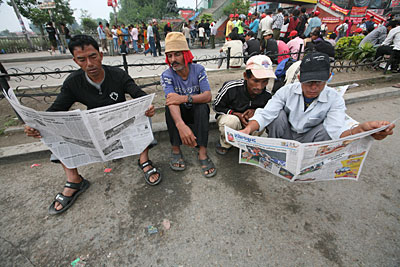 KIRAN PANDAY |
Like most other capital cities in the underdeveloped world, Kathmandu is almost a self-contained country within a country. It is more connected with the other metropolises of the world than with its own hinterland. As long as its supply lines are open, the residents of Kathmandu do not worry much about whatever is happening elsewhere in the country.
When the Maoist hordes began to arrive for the May Day rallies and subsequent anti-government protests, the denizens of the valley didn't know what to make of them. They looked different, dressed differently, talked in different languages and yet displayed a unity of purpose seldom seen among the middle-class Newar, Bahun, Madhesi and Janjati activists of Kathmandu.
Even though the majority of the nearly four million Nepalis in Kathmandu are first-generation immigrants with living familial ties in ancestral villages, few of us have been able to gauge the level of frustration in the countryside. But for the youngsters of the 15-20 age group (old enough to aspire, but too young to understand the limitations of an underdeveloped economy) the villages hold no jobs, no services and no hope.
Ever since the country embraced wholesale liberalisation, agriculture � the mainstay of the rural economy � has been in a tailspin. Central grants have been used to hire mechanical excavators to dig roads so that mini-trucks carrying cola, beer bottles and biscuits can be delivered safely and cheaply to every doorstep. Remittance inflows and the cash from land sales have been spent to acquire motorbikes and mobile phones that burden one's monthly
budget without adding anything to income.
In a consumer economy, market expansion is more important than building irrigation channels or providing basic services. Community radio or commercial television, everybody advertises soda drinks, noodles or English 'boarding' schools. The media explosion since the 1990s has hardly given voice to the voiceless. It merely magnifies what the centre has to say or sell to the rest of the country.
That could be why so little is known about the people who encircled the city in a red arc running along the entire stretch of the twenty-seven kilometre long Ring Road. Even by conservative estimates, nearly 100,000 stood in a human chain to show that they were here to enforce the will of the periphery. The media has missed the real story in the deluge of news emanating from the residences of the male Bahun politicians who do not seem to realise that they are all in a boat that is barely afloat.
Most participants at the protest rallies have perhaps come to the city of their own accord. At least some have defied the whip of the Youth Force (the militant youth wing of UML) to respond to the call of local Maoist commissars. But the media coverage in Kathmandu has made it look as if gullible villagers have been either lured or threatened into taking part in protest programs.
Media in countries with a flourishing independent press but limited public access to newspapers and television, due to illiteracy and poverty, are inherently right-of-the-centre. The advertising market ensures that it can't be otherwise. Businesses seldom want to upset the applecart of the status quo unless their own interests are at stake. The problem with such a media system is that civil society has limited access to the masses and even less influence upon public opinion.
In the absence of mediated channels of communication, those who work at the grassroots exercise greater powers of persuasion. At least since the mid-nineties, the only mediators villagers in Nepal have seen are the Maoists. True, they have been often brutal in their methods, but at least they are one of their own. In a society where feudal norms are still strong, a tormentor holds the promise of saving one from bigger tyrants.
The mainstream media's antipathy towards the political agenda of the Maoist is somewhat understandable: its advertisers bear no love for the enforcers of donation diktats. But the collective failure to understand the motivation of protestors shows that the Kathmandu-centric media has a long way to go before it can claim to be national.



